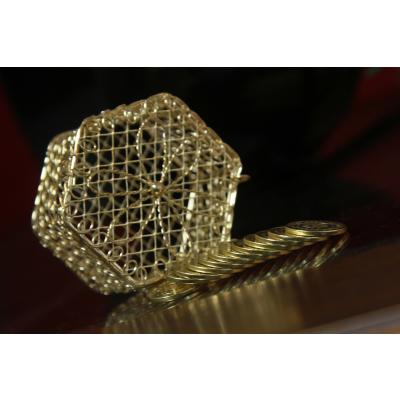
Posted in: World Wedding Customs
 Mexican wedding ceremony traditions include the Arras, a special box holding 13 coins. Image by Jay Bautista from Pixabay.
Mexican wedding ceremony traditions draw heavily from ancient Native Mexican Indian customs. However, today these customs have been folded into the country's predominant Roman Catholic faith. Today, most couples in Mexico choose a Catholic wedding ceremony.
Mexican wedding ceremony traditions include the Arras, a special box holding 13 coins. Image by Jay Bautista from Pixabay.
Mexican wedding ceremony traditions draw heavily from ancient Native Mexican Indian customs. However, today these customs have been folded into the country's predominant Roman Catholic faith. Today, most couples in Mexico choose a Catholic wedding ceremony.
Mexican Wedding Mass
A Mexican wedding ceremony begins with the procession down the aisle. Bride and groom walk together, accompanied by their parents. Not only does this custom serve to honor their parents, it also signifies parental consent and approval of the marriage. Of course, the ceremony follows the order of a traditional Roman Catholic wedding mass, scripted by order of the Vatican. Once the bride and groom reach the altar, their parents take their seats and the religious portion of the mass begins with a welcome by the priest. Following the welcome, the congregation sings a song before selected passages of Scripture are read by members of the church. At this point, one of the bride's godmothers (las padrinas) presents the couple with a special Bible, a rosary, and a decorative pillow. Then the priest delivers the homily, a message based on Scriptures to encourage and inspire the whole congregation. Finally, the wedding portion of the service commences.Mexican Wedding Ceremony
Statement of Intentions
The ceremony begins with a statement of intentions. The priest asks the bride and groom a series of questions. First, he establishes that each is free to choose marriage to each other. Next, he inquires as to their intentions to remain faithful to one another. Finally, he asks if they agree to bear and raise children according to the customs of the Roman Catholic Church. To each of these questions, the bride and groom respond "I have" or "I am." (source)Wedding Vows & More
Following this rite of inquiry, the couple exchanges their wedding vows. At this point, the priest takes las arras, the box of 13 coins, from los padrinos and offers a blessing over them. Then he hands them to the bride so she can perform her part of the ritual. Next, a member of the congregation walks to the podium to read out the universal prayer of intercession. Prayers are recited for those in their parish who are sick or in need. The preparation of the Eucharist (bread and wine for communion) takes place next, followed by a recitation of the Lord's Prayer and the offering of a special nuptial blessing by the priest. At this point, the bride and groom kneel upon their special pillow and the priest invites a prayer of silence. Following this prayer, the first native-inspired tradition begins - el lazo. Once bound together by the cord of unity, the couple exchanges their wedding rings.Communion
After a song and another prayer, the priest offers communion, first to the newly wedded couple, then to all of their Catholic wedding guests. Following communion, the priest closes the ceremony and the mass with a final blessing. Just before the recessional, the bride offers her bouquet, often a spray of white roses, to the Virgin of Guadalupe in a ritual called la ofrenda. Kneeling at the feet of the icon, the bride offers a prayer of thanks to the Virgin Mary. Finally, the bride, groom, and los padrinos follow the priest and the altar boys back down the aisle and out of the church to the strains of celebratory music. Click here to read about the specific customs drawn from Native Mexican Indian culture. ~Angela Magnotti Andrews5 years ago
21 view(s) 